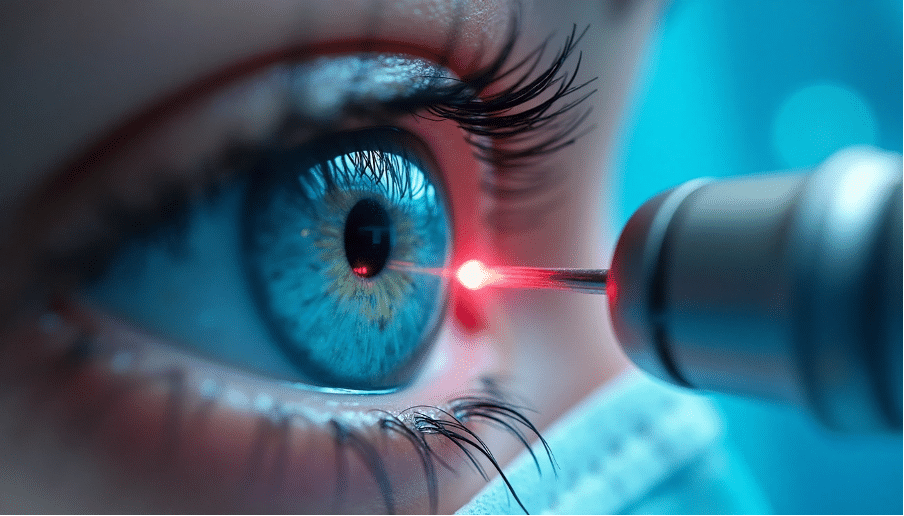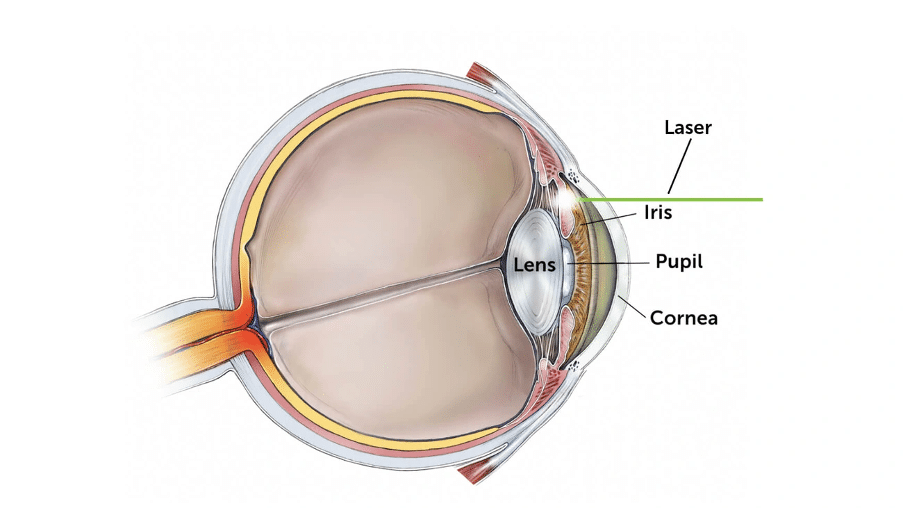Laser eye surgery has transformed millions of lives worldwide in its nearly four-decade history. The procedure’s risks remain remarkably low compared to other medical treatments. More than 30 million successful procedures stand as proof of its effectiveness across the globe.
It’s natural to ask “is laser eye surgery safe?” The procedure has an excellent safety record, yet some complications can occur. Nearly 95% of patients might experience dry eyes after surgery. About 20% of people notice changes in their vision like glare, halos, or light sensitivity. Modern LASIK carries an infection risk of just one in 20,000 cases. This rate is by a lot lower than contact lens wear, which poses three times the risk.
This piece breaks down what it all means, their chances of occurring, and ways to reduce these risks. Quality equipment, expert surgeons, detailed preoperative testing, and thorough follow-up care at Precision Vision London play vital roles. We’ll walk you through both common and rare complications to help you decide if laser eye surgery suits your needs.

Understanding the Types of Laser Eye Surgery Risks
Patients need to understand different types of risks before getting laser eye surgery. This knowledge helps them make informed decisions. Serious complications rarely occur, but you should know what might happen during each stage.
Risks during the procedure
LASIK surgery’s most critical step involves creating the corneal flap, which can lead to various complications. Flap-related issues make up the majority of problems during surgery. Medical literature shows rates between 0.3% and 1.0%. These problems include incomplete flap formation in about 3.66% of cases, free caps in 1.83%, and buttonhole flaps in 0.73%.
Patients lose suction in 0.06% to 4.4% of cases. On top of that, epithelial defects show up in 0.6% to 14% of cases, especially when you have older patients or those with epithelial basement membrane dystrophy.
Risks after the procedure
Dry eye syndrome affects about 60-70% of patients after surgery. The good news is this condition usually goes away within months as corneal nerves heal. Vision might not be fully corrected in 5% to 51% of cases, which doctors call residual refractive error. Some patients see glare, halos, or star-bursting patterns around lights.
Flap dislocation needs immediate medical attention and happens in 0.012% to 2.5% of cases. Most cases happen in the first week after surgery, so patients should avoid rubbing their eyes during this time.
Temporary vs. long-term complications
Laser eye surgery complications are usually temporary. Vision becomes stable within three to six months after surgery. Patients’ dry eyes, light sensitivity, and changing vision get better as healing happens.
Some complications can last forever if not treated properly. The cornea becomes too thin and weak in about 0.04% to 0.6% of cases, a condition called corneal ectasia. Vision can get worse over time without treatment.
Diffuse Lamellar Keratitis (DLK) affects the interface in 0.13% to 18.9% of cases. Early detection usually leads to successful treatment. Permanent vision loss remains extremely rare, happening in less than 1 in 5000 patients.
Common Complications and Their Causes
Most patients get excellent outcomes from laser eye surgery. You should know the most common risks to set realistic expectations. Let’s look at these complications and what causes them.

Dry eyes and tear film disruption
Dry eye tops the list of complications after laser eye surgery. This condition affects virtually all patients right after the procedure. LASIK surgery disrupts corneal nerves and reduces tear production temporarily. Research shows 95% of patients notice dry eye symptoms immediately after surgery. About 60% still have these symptoms after a month. The good news is symptoms usually get better within 6-12 months as corneal nerves heal.
Dry eye can affect quality of life by a lot. Patients with moderate-to-severe cases report discomfort levels like those with moderate-to-severe angina. This remains a major reason why patients feel unsatisfied after surgery.
Night glare, halos, and starbursts
Temporary visual disturbances in low light are common side effects. Patients might see glare, halos (glowing rings around lights), and starbursts (star-like glare from light sources). These effects become most noticeable during night driving or in dim lighting.
Corneal swelling during healing usually causes these issues. Patients with larger pupils or higher degrees of refractive correction face more risk of these symptoms. Night vision problems usually clear up within weeks to months as eyes heal fully.
Overcorrection or undercorrection
The laser might remove too much or too little corneal tissue, leaving vision imperfectly corrected. Nearsighted patients experience undercorrection more often. Overcorrection happens more during retreatment procedures.
Several factors determine the likelihood – patient’s healing response, corneal thickness, and degree of refractive error. Doctors might need to perform enhancement procedures 3-6 months after the original surgery.
Corneal flap issues
Flap complications include incomplete flaps, buttonholes, free caps, and post-surgery problems like wrinkles or dislocations. Research shows intraoperative flap complications range from 0.16% to 15%.
Poor adhesion can lead to flap dislocation, often spotted during the first post-surgery check-up. Epithelial ingrowth occurs when epithelial cells grow into the interface because of space left at the sidecut.
Infection and inflammation
Serious infections rarely occur after laser eye surgery – about 1 in 10,000 cases. Contact lens wear actually poses a higher risk of vision-threatening infection. Inflammation can show up as diffuse lamellar keratitis (DLK) beneath the corneal flap. Doctors treat this with anti-inflammatory eye drops and use antibiotic eye drops for infections. Quick detection and treatment help prevent long-term complications.
Rare but Serious Risks to Be Aware Of
Beyond common complications, some rare but serious risks need our attention. These conditions don’t happen often, but doctors must spot and treat them quickly.
Corneal ectasia and long-term instability
Corneal ectasia happens when the cornea gets progressively thinner and bulges after surgery. Studies show this happens in about 0.033%-0.6% of cases. Patients develop increasing myopia with astigmatism. Young age, high myopia, thin corneas, and unusual corneal topography increase the risk. Doctors use corneal collagen cross-linking (CXL) to strengthen the weakened cornea. Precision Vision London’s track record shows progressive ectasia is rare – just 1 in 20,000 cases.
Epithelial ingrowth
Surface corneal cells sometimes grow under the flap edge. This affects less than 1% of LASIK patients. The number goes up to 10%-20% for people who need a second procedure.
Most patients notice symptoms within four weeks. Some cases have shown up even ten years later. People with epithelial basement membrane dystrophy, hyperopic correction, and flap-related issues face higher risks. Early signs feel like something in the eye, but vision can get worse over time.
Diffuse lamellar keratitis (DLK)
Doctors call DLK the “Sands of Sahara.” It causes non-infectious inflammation in the LASIK interface and affects 0.13%-18.9% of cases. Symptoms usually show up within 24-48 hours after surgery. About one in 500 patients gets this temporary inflammation. Strong topical steroids usually clear up the condition without lasting problems.
Pressure-induced stromal keratitis (PISK)
PISK looks like DLK but happens because steroids increase eye pressure. Unlike DLK, PISK shows up more than a week after surgery. Steroids don’t help much, but pressure-lowering medications do. PISK affects about 0.04% of patients (1 in 2,500 cases). Quick diagnosis helps avoid giving more steroids, which would make things worse.
Vascular occlusion and retinal damage
Vascular occlusion is very rare but serious. It might happen from temporary pressure increase during corneal flap creation. The chances are tiny – less than 1 in 1,000,000. People with heart problems face slightly higher risks. Precision Vision London’s thorough pre-surgery screening helps identify these risk factors early.
How Precision Vision London Minimises Risk
Precision Vision London weaves safety into every aspect of our practise. Our innovative technology, expert surgeons, and strict protocols create a detailed approach that minimises risks and maximises successful outcomes.
Advanced diagnostic and surgical technology
Precision Vision London uses the world’s highest-performance eye lasers for refractive and therapeutic corneal surgery. Our clinic uses Advanced Wavefront technology in all procedures to give optimal results for every patient. This technology does more than standard treatments by creating detailed corneal maps and tailoring the correction to each eye’s unique features. Then, this approach improves visual outcomes and reduces the risk of night disturbances such as glare and halos.
Highly experienced UK-registered surgeons
Our surgeons are UK-trained NHS consultants with over 10 years of specialist experience. Dr. Pillai, our Medical Director, was one of the first surgeons in the UK to perform bilateral LASIK treatment on both eyes on the same day. His 30 years of experience as an ophthalmic surgeon in refractive and corneal procedures ensures top-quality care.
Strict safety protocols and hygiene standards
Our clinic maintains strict safety standards throughout every procedure. Advanced diagnostic tools help us detect and manage potential complications early. We focused on maintaining sterile conditions, which substantially reduces the already minimal risk of infection—which stands at approximately just 1 in 10,000 cases.
Comprehensive pre-op screening and aftercare
Each patient gets a full picture during their original consultation. This includes prescription evaluation, eye health examination, and review of other health conditions that might affect treatment. This detailed screening helps us select suitable candidates for surgery, which substantially reduces complication risks. On top of that, our one-year Care Guarantee supports you throughout your recovery.
Personalised treatment plans for every patient
Each eye is unique. So, your surgeon oversees every step of your treatment plan, from first consultation through follow-up appointments. This personal approach ensures continuous care and treatment that matches your specific needs. Every procedure has risks—but the right clinic makes them minimal and manageable. Precision Vision London values transparency, safety, and personal care. Book a consultation today to get clarity before you commit.
Conclusion
Laser eye surgery ranks among the safest optional procedures today. Millions of successful treatments worldwide prove this point. People naturally worry about complications, but the real risks are nowhere near as serious as most think. You might experience dry eyes, night vision issues, or minor focusing problems. These symptoms usually clear up within months as your eyes heal. Serious complications happen less often than problems from wearing contact lenses long-term.
The clinic you choose will shape your safety and results substantially. Precision Vision London makes these minimal risks even lower through several key factors. Their advanced Wavefront technology maps your cornea in detail to match your eye’s unique features. Their UK-registered surgeons bring decades of specialist experience to guide you through the whole process. Full pre-operative screening spots risk factors early. Their strict safety measures stop preventable complications before they start.
Quality aftercare plays a crucial role too. Precision Vision London’s one-year Care Guarantee gives you ongoing support as you recover. This personal touch means they address any concerns quickly, which stops small issues from becoming bigger problems.
Without doubt, you should think over your decision to have laser eye surgery carefully. Every surgery has some risks, but you need to balance these against the benefits. Freedom from glasses and contacts, better life quality, and long-term savings make it worth considering. While all procedures carry risks, the right clinic keeps them minimal and manageable. Precision Vision London puts your safety first with clear communication and personal care. Book a consultation to learn more before you decide.
Key Takeaways
Understanding the risks of laser eye surgery helps you make an informed decision about this highly successful procedure that has treated 30 million people worldwide.
- Laser eye surgery has excellent safety records with serious complications occurring in less than 1 in 5,000 patients, making it safer than long-term contact lens wear.
- Common temporary side effects include dry eyes (affecting 95% initially), night glare, and halos, but these typically resolve within 6-12 months as eyes heal.
- Rare but serious complications like corneal ectasia occur in only 0.033%-0.6% of cases, whilst infection rates are just 1 in 10,000 procedures.
- Choosing an experienced clinic with advanced technology, comprehensive screening, and expert surgeons dramatically reduces already minimal risks and ensures optimal outcomes.
- Thorough pre-operative assessment and ongoing aftercare are crucial for identifying potential issues early and managing any complications that may arise effectively.
The key to minimising risks lies in selecting a reputable clinic that prioritises safety protocols, uses cutting-edge technology, and provides comprehensive care throughout your entire treatment journey.
FAQs
Q1. How safe is laser eye surgery compared to other medical procedures? Laser eye surgery is considered one of the safest elective procedures available. The risk of serious complications is less than 1 in 5,000 patients, which is lower than the risks associated with long-term contact lens wear.
Q2. What are the most common side effects of laser eye surgery? The most common side effects include temporary dry eyes (affecting up to 95% of patients initially), night vision disturbances such as glare and halos, and minor refractive errors. These typically resolve within 6-12 months as the eyes heal.
Q3. How long do the effects of laser eye surgery last? Laser eye surgery permanently reshapes the cornea, providing long-lasting vision correction. Most people experience the benefits for many years, often decades. However, natural age-related changes like presbyopia can still affect vision over time.
Q4. What measures does Precision Vision London take to minimise risks? Precision Vision London employs advanced Wavefront technology, highly experienced UK-registered surgeons, strict safety protocols, comprehensive pre-operative screening, and personalised treatment plans. They also offer a one-year Care Guarantee for ongoing support throughout the recovery process.
Q5. Is it possible to need a second procedure after laser eye surgery? In a small percentage of cases, an enhancement procedure might be needed if there’s a regression of vision. However, this is typically separate from age-related changes and is relatively uncommon with modern laser eye surgery techniques.
Authors & Reviewer
-
 Olivia: Author
Olivia: AuthorHi, I'm Olivia, a passionate writer specialising in eye care, vision health, and the latest advancements in optometry. I strive to craft informative and engaging articles that help readers make informed decisions about their eye health. With a keen eye for detail and a commitment to delivering accurate, research-backed content, I aim to educate and inspire through every piece I write.
-
 Dr. CT Pillai: Reviewer
Dr. CT Pillai: ReviewerDr. CT Pillai is a globally recognised ophthalmologist with over 30 years of experience, specialising in refractive surgery and general ophthalmology. Renowned for performing over 50,000 successful laser procedures.

